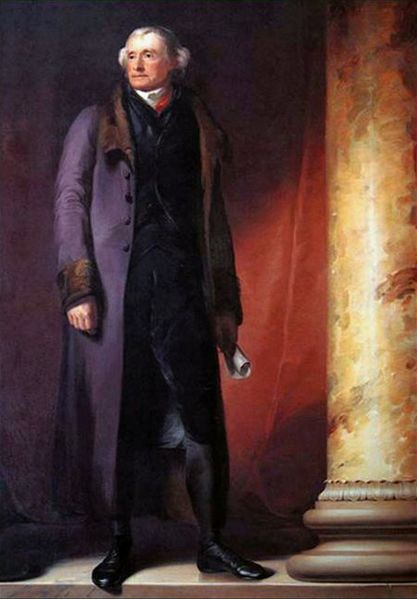When Jefferson became President, he and his Secretary of War, Henry Dearborn, devised a plan to reform the U.S. Army with a view to reducing its size and educating a new generation of officers committed to democratic principles and skilled in mathematics, science, and the military arts who could serve the nation in both peace and war. Just two months after Jefferson's inauguration in 1801, Dearborn announced that the president had "decided on the immediate establishment of a military school at West Point," appointing Major Jonathan Williams "to direct the necessary arrangements for the commencement of the school."[1]
The Academy's curriculum was based on an exchange between Jefferson and Pierre S. Du Pont de Nemours, with Jefferson asking, "what are the branches of science which in the present state of man, and particularly with us, should be introduced into an academy"?[2] Du Pont proposed an all inclusive plan of national education with primary schools, colleges, and four specialty schools – medicine, mines, social science, and legislation – and "higher geometry and the sciences that it explains." With engineering "urging forward the other sciences," this school would be of the greatest benefit to the nation, Du Pont explained. As he told Jefferson: "No nation is in such need of canals as the United States, and most of their ports have no means of exterior defense."[3]
On March 16, 1802, Jefferson affixed his name to the Military Peace Establishment Act, directing that a corps of engineers be established and "stationed at West Point in the state of New York, and shall constitute a Military Academy."[4] The academy's sole function would be to train engineers, and Williams, a grandnephew of Benjamin Franklin, was named superintendent. On July 4, 1802, the U.S. Military Academy formally opened for instruction. "Our leading star," Superintendent Williams said, "is not a little mathematical school, but a great national establishment . . . We must always bear it in mind that our officers are to be men of science, and such as will by their acquirements be entitled to the notice of learned societies."[5]
The success of the Academy's instruction in engineering was highlighted during the War of 1812, when the British failed to capture any works constructed by a graduate of West Point. The historian Henry Adams noted, "had an engineer been employed at Washington . . . , the city would have been easily saved."[6] Adams further remarked that Jefferson's military academy "doubled the capacity of the little American army for resistance, and introduced a new and scientific character into American life."[7]
In January 1821, U.S. Military Academy Professor Jared Mansfield wrote to Jefferson from West Point:
The Superintendent, Officers, Professors, Instructors, & Cadets of the U. States' Mil. Academy, impressed, with a high sense of the great services, you have rendered the Nation, & that this Institution, with which they are connected, originated under your patronage, & presidency, are anxious for some special, & appropriate memorial of your person, which may descend to posterity.[8]

The library at the U.S. Military Academy, Mansfield informed Jefferson, had portraits of George Washington and of Jonathan Williams, the academy's first superintendent. Would Jefferson, Mansfield asked, "gratify" them by sitting for Thomas Sully, one of the "best Portrait Painters of our Country," at Monticello?[9]
Jefferson himself said that he "ever considered that establishment as of major importance to our country, and in whatever I could do for it, I viewed myself as performing a duty."[10] Today, the full length Thomas Sully portrait of Thomas Jefferson commissioned by the "Superintendent, Officers, Professors, Instructors, & Cadets" of the United States Military Academy hangs in the Jefferson Library and Learning Center at West Point and a half-length copy hangs in the Entrance Hall at Monticello.
- Christine Coalwell, 2001. Originally published as "West Point: Jefferson's Military Academy," in Monticello Newsletter 12 (Winter 2001). Revised by David Thorson, 2023.
ADDRESS:
931 Thomas Jefferson Parkway
Charlottesville, VA 22902
GENERAL INFORMATION:
(434) 984-9800
